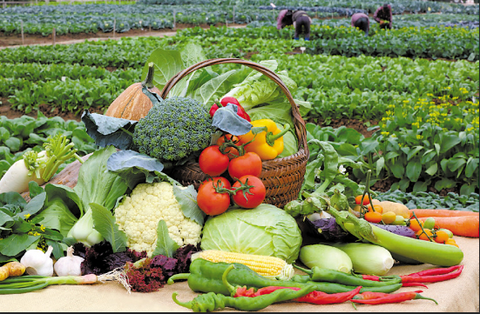Cucumbers are one of the most popular and versatile vegetables to grow in home gardens. Whether you prefer them fresh in salads, pickled in jars, or blended into refreshing summer drinks, cucumbers are a staple crop that thrives in a variety of climates. In this comprehensive guide, we'll explore everything you need to know to successfully grow cucumbers in your garden, from planting to harvesting, as well as the many benefits of cultivating this nutritious and delicious vegetable.

Selecting the Right Varieties
Before you start growing cucumbers, it's essential to choose the right varieties for your garden and growing conditions. There are several types of cucumbers to choose from, including slicing cucumbers, pickling cucumbers, and specialty varieties. Some popular cucumber varieties include:
- Slicing Cucumbers: These cucumbers are typically larger and have a thicker skin, making them ideal for slicing and adding to salads or sandwiches. Varieties like 'Marketmore' and 'Straight Eight' are excellent choices for slicing cucumbers.
- Pickling Cucumbers: These cucumbers are smaller and have a thinner skin, making them perfect for pickling. Varieties like 'National Pickling' and 'Boston Pickling' are popular choices for pickling cucumbers.
- Specialty Varieties: There are also specialty varieties of cucumbers, such as English cucumbers (long and slender with thin skin) and Armenian cucumbers (long and ribbed with mild flavor). These varieties offer unique textures and flavors for culinary experimentation.
Planting and Growing Conditions
Cucumbers thrive in warm weather and require plenty of sunlight, well-drained soil, and regular watering to grow successfully. Here are some tips for planting and caring for cucumber plants:
- Planting: Plant cucumber seeds or seedlings in the garden after the last frost date in your area. Choose a sunny location with fertile soil and plenty of room for the plants to spread out.
- Spacing: Space cucumber plants about 12 to 24 inches apart in rows, allowing ample room for growth and airflow between the plants.
- Support: Consider providing support for vining cucumber varieties by using trellises, cages, or stakes. Vertical gardening can help maximize space and improve air circulation, reducing the risk of disease and pests.
- Watering: Keep the soil consistently moist but not waterlogged, especially during hot weather. Water cucumber plants deeply at the base of the plants to encourage strong root development.
- Fertilizing: Apply a balanced fertilizer or compost to the soil before planting, and supplement with additional fertilizer throughout the growing season as needed.

Harvesting and Enjoying Cucumbers
Cucumbers are typically ready to harvest about 50 to 70 days after planting, depending on the variety and growing conditions. Here are some tips for harvesting and enjoying cucumbers:
- Harvesting: Harvest cucumbers when they reach the desired size and color for the variety you're growing. For slicing cucumbers, harvest when they are 6 to 8 inches long and have a deep green color. For pickling cucumbers, harvest when they are 2 to 4 inches long and have a bright green color.
- Harvesting Technique: Use a sharp pair of scissors or garden shears to cut cucumbers from the vine, being careful not to damage the plant. Regularly harvest cucumbers to promote continued production during the growing period.
- Enjoying Fresh: Enjoy fresh cucumbers sliced in salads, sandwiches, or wraps, or simply eaten as a healthy snack with dip or hummus.
- Preserving: Preserve excess cucumbers by pickling, canning, or freezing them for later use. Homemade pickles and relishes are a delicious way to enjoy cucumbers year-round.

Benefits of Growing Cucumbers
- Nutritional Value: Cucumbers are low in calories but high in essential nutrients, making them a healthy addition to your diet. They are rich in vitamins C and K, as well as potassium, magnesium, and fiber. Incorporating cucumbers into your meals can help support hydration, digestion, and overall health.
- Versatility in Cooking: Cucumbers are incredibly versatile in the kitchen, lending themselves to a wide range of culinary applications. Enjoy them fresh in salads, sandwiches, and wraps, or use them to add crunch and flavor to soups, stews, and stir-fries. Cucumbers can also be pickled, fermented, or juiced to create a variety of delicious dishes and beverages.
- Hydration: With their high water content, cucumbers are an excellent hydrating snack, especially during the hot summer months. Eating cucumbers can help replenish fluids and electrolytes lost through sweating, keeping you cool, refreshed, and hydrated throughout the day.
- Easy to Grow: Cucumbers are relatively easy to grow, making them an ideal choice for beginner gardeners. With the right growing conditions and proper care, cucumbers can produce abundant yields of crisp, flavorful fruits that are perfect for snacking, cooking, and preserving.
- Pollinator Attraction: Cucumber plants produce bright yellow flowers that attract bees, butterflies, and other pollinators to your garden. By growing cucumbers, you can help support pollinator populations and promote biodiversity in your backyard ecosystem.
Conclusion
Growing cucumbers is a rewarding and enjoyable experience that offers numerous benefits, from nutritious harvests to culinary versatility. By following this guide and incorporating best practices for planting, care, and harvesting, you can cultivate a bountiful crop of cucumbers in your garden and enjoy the many delights they have to offer. Whether eaten fresh, pickled, or used in recipes, homegrown cucumbers are sure to add flavor, nutrition, and satisfaction to your meals and snacks throughout the growing season.









